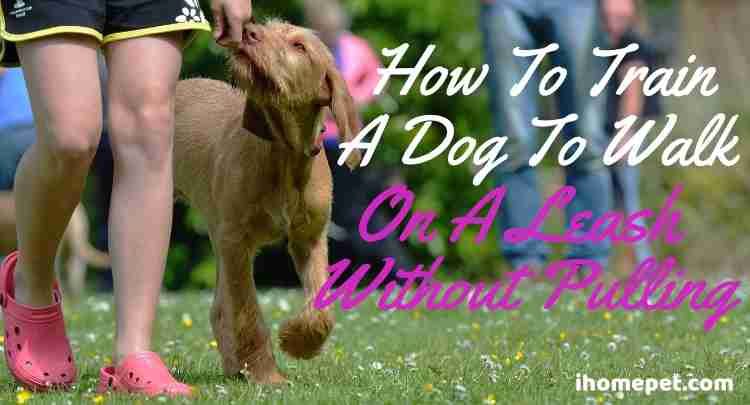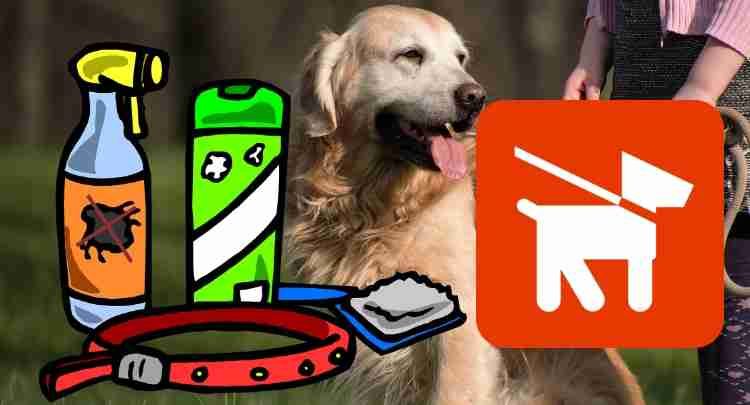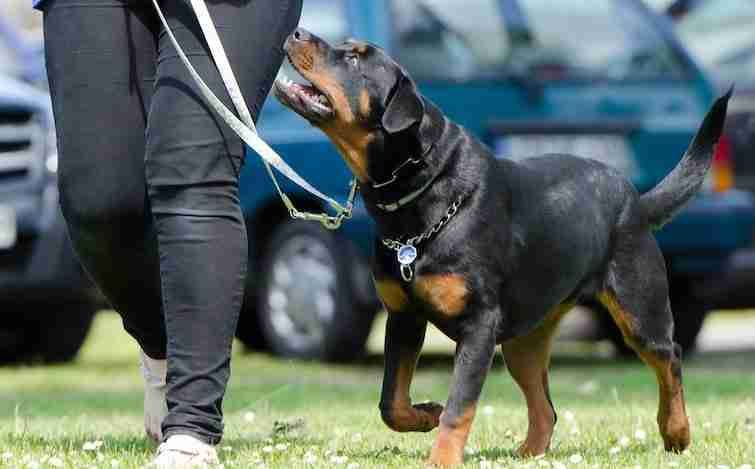If taking a walk with your dog on your side has been your dream, this article will help you make that dream come true. Some dogs do not like to have a leash on, while some dog owners do not know how to train a dog to walk on a leash without pulling. Although teaching your dog leash manners is difficult, it is fun, strengthens your bond, and worth the effort.
A trained dog can walk on a leash without pulling your arms. It may be amusing to look at your dog bouncing off the leash like a kangaroo, but it is not fun if you are the one holding one end of the leash.
7 Tips On How To Train A Dog To Walk On A Leash Without Pulling

Train your companion not to pull using a leash, training collar, and a few treats. Teaching your dog not to pull on an area with less distraction and somewhere you can walk in a circle, or a straight line is more effective.
#1 Introduce your pooch to the leash and collar
To get your dog to tolerate the leash, use positive reinforcement and treats. Take out the leash from your back. When your dog looks at it, reward them with a treat and the word “Yes!” or a clicker. The first time you use it, just leave it on for a few minutes before removing it.
This should be done several times a day to grow a routine. Keep the collar on for a little longer each time you make him wear it. With time, your dog will begin to get used to the leash. Ensure to reward your friend during leash training. Ensure to use soft verbal commands to prevent your dog from panicking.
#2 Try to use the click and treat training method
To use a clicker or other marker with your dog, you must first teach him what the marker means. Pair your chosen marker with a reward, a process known as “loading the clicker.” So, press and treat right away. Your dog will learn that the marker signals the arrival of a reward after between 10 and 20 repetitions.
For instance, when teaching your family dog how to walk on a leash, make it clear you are rewarding leashing. Reward the dog when it’s walking on the leash without pulling and not when with no leash. After the dog learns the obedience classes, you will not need the marker anymore.
#3 Allow the puppy to walk towards you
To begin, step back between 1 and 3 feet away from your puppy and wiggle a favorite toy or food reward in front of its nose. Call out your puppy’s name and “here” at the same time for the dog to pay attention. Use a friendly, upbeat tone of voice when commanding the dog.
When your puppy approaches you, praise and reward him lavishly with a toy or steak, then do it again repeatedly. With time it will get used to it, and it will get to you when you call it even without giving it a treat.
#4 Take a few practice walks and do not pull on the leash
This will help your family dog master the walking technique without pulling. If your dog is not interested in food rewards, you can give him a tug toy or throw a ball. Repeat the practice regularly until your dog learns to walk without pulling.
You can decide if you want your dog to walk on your right or left side. When it walks by your preferred side, reward it with cheese, fresh meat, or something else it likes by your thigh. The treats will encourage the dog to remain at your preferred side even without having to pull on the lease.
#5 Use positive reinforcement when training your dog
Positive reinforcement is an extremely successful method of dog training. It entails doing something as soon as a behavior happens in order to increase the frequency of the behavior. It is one of the most effective methods for influencing or modifying your dog’s actions since the reward encourages them to replicate the behavior.
You will get a trained dog, and you will keep the spirit of that dog if you teach it with positive reinforcement. To help change actions, correct bad behaviors, and even teach tricks, positive reinforcement, a professional trainer often uses visual prompts, hand gestures, rewards, clickers, toys, and even games.
#6 Dog behavior issues and How to deal with them
Some common dog behavior issues such as barking, digging, chewing, and biting are mishandled or misunderstood by dog owners often. The first step of solving and preventing dog behavior is thoroughly understanding the common behavior. To help you prevent or control these issues, you need a professional trainer for a solid foundation of obedience training.
However, before you begin training, it is essential to understand why your dog developed these behaviors. For instance, your family dog could be barking trying to warn or alert you, or probably it is chewing of late since its puppy teething time. Ensure to address any causes of these behaviors before you begin training.
#7 What is the “heel position” and how to use it?
The dog should walk alongside the handler, not in front of or behind him, while obeying the heel order. Not only is this a necessary skill for a harmonious walk between dog and owner, but it is also necessary for some circumstances, such as walking down a busy street or across a crowded walkway.
Begin by walking around a large room or up and down a hallway within the building. Call your dog and direct his attention to the side you want him to walk on (any side you choose but left is the recommended heel side). Use a clicker or say “yes” as soon as your dog approaches you, then praise and reward.
Choose The Right Training Tool For Walking Your Dog

One of the most important resources you should have is the right training tools for effectiveness. In some areas, it is required by law to leash and collar your dog outside. However, there are wide ranges of training tools to choose from, and it can be daunting. How do you know which one is best for your dog? Which is the right way to use it to gain power while walking?
Buckle Collar
These collars are just what they sound like buckle-fastened collars. They are y made of cotton, leather, or nylon and come flat or rolled. They are useful for dogs that pull and “slip” their collars. Buckle collar provides the owner with more control. They are adjustable, but once fastened, it is not possible to tighten them on the dog’s neck.
No-Pull Harness
Non-pull harnesses, as the name implies, act to reduce the dog’s tendency to pull hard on their lead during walks. The clip is in the front here, as opposed to the back of a conventional harness, which makes it easier for dogs to pull strongly on the lead from their chest. We found that Stylish Hound carries a wide variety of non-pull harnesses that provide maximum comfort.
Martingale Collar
Also known as a no-slip collar, it is best for a dog breed that has a narrow head than the neck. The dog’s collar loop design prevents it from slipping from the dog’s head. The collar is friendly, safe and prevents the dog from pulling and endangering himself. You can use the collar either positively or negatively.
Correction Collar
When used correctly, a correction collar’s purpose is to warn the dog when it makes a mistake during obedience training. This is accomplished by sound (the chain snapping back when pulled) and tactility (light touch on the dog’s neck).
Compression Harness
This full-body carriage fits dogs like a vest, with the leash attaching to one point on their body and minimize the dangers of pulling back on it. It’s a good way to keep your dog from pulling on the leash too hard. The compression harness allows for proper shoulder movement, making it an excellent tool for obedience training.
Head Halter Harness
A head halter will gently restrain your family dog or turn him away from other negative dogs so that good behavior can be rewarded (turning away). When you make good things happen in the presence of other dogs, the dog will learn that having other dogs around is a positive idea.
Frequent Asked Questions

What side should I allow my dog to walk on?
It is up to the owner to decide which side the dog will take. Most people claim that the left side is traditional. However, the decision is still yours. Hunting dogs are taught to remain on their human’s left side by professional trainers, but most dogs do not care, and they do not stick at the side they are trained to stick to. Experts, on the other hand, advise choosing a side — left or right — and sticking to it, so the dog does not trip you going back and forth.
What should I do if the dogs pulling on the leash?
Walk forward with a loose leash, and each time the dog tightens the leash, turn his head, take a few steps back, make your dog sit, and start over. Your dog can eventually understand that walking on a loose leash helps the walk to continue, while pulling causes the walk to come to a halt.
How do I stop my dog from barking aggressively at another dog?
You can stop your dog from barking at other dogs in the house by monitoring when he barks. You should start by ensuring that you are calm and assertive no matter how angry you are at the dog. Shouting at it will only make the situation worse.
You should also block your dog from seeing the other dog by standing in front of it. Another way to keep your dog from barking aggressively at other dogs is by creating time for it to be with other dogs. This way, it will learn to accommodate them.
Which is better to use a collar or harness?
A dog harness makes it easier to control and handle any dog compared to a dog collar, particularly those with less-than-perfect leash manners. Harnesses have other benefits, such as giving you more balance and being easier on your arms and back if you have a big or heavy dog. The harness also discourages pulling. The use of a collar can also result in a collapsed trachea for some dogs.
Summary
With the tips mentioned above, it is easy to train your dog to be a responsible one. Hiring a professional to do the training for you or enrolling your dog for dog training classes, especially if you have limited time to handle the task yourself, is wise. Start training your dog while it is still a puppy. No one would hate a well-mannered dog. Train it or have it trained and enjoy the benefits that come with it.
Last Updated on 16/03/2025 by Karen Snow
Hi! I’m Karen and a certified dog lover. As a freelance writer and blogger, I do my best to squeeze in some time with my dogs, learning more about the way they act and how I can make sure that they continue to stay well-cared for by yours truly.
My dogs have helped me through a lot, and this is my way of giving back to them! Besides animals, I also love to travel and cook, having explored my country’s restaurants and unique places. Follow me as I show you all the amazing tips and bits of information I learn along the way about our furry friends!
